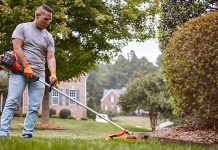
The winner of a 2013 SIMA Silver Innovation Medal and a 2012 Good Design Award, New Holland’s BigBaler range is said to have raised the benchmark in the large square baling sector to become the default choice for professional baling operations and biomass contractors. The BigBaler can produce up to 110 bales an hour. The MaxiSweep pickup ensures smooth feeding and has contributed to a 20% capacity increase when compared with previous models.
Bale density has been improved by up to 5% thanks to the enhanced pre-compression chamber and SmartFill technology, which uses a network of sensors to help the operator maintain even flake formation for uniformly dense bales. Advanced Precision Land Management functions such as ActiveWeigh on-the-go bale weighing technology can be recorded, together with moisture content, date and time and the bale’s GPS location to create precise yield and field mapping data. In this way, inputs can be fine-tuned to increase productivity and profitability for future seasons.
The international jury of agricultural experts at SIMA was also impressed by the BigBaler’s safety features. The BigBaler is produced in Zedelgem, Belgium. The facility is home to New Holland’s product management and development teams together with the testing and manufacturing departments, which ensures close collaboration to guarantee competitiveness, functionality and quality. New Holland South Africa currently has BigBalers in stock.

The BigBaler 890 crop-cutter model.
Safe operation
The BigBaler range was designed with safety in mind as New Holland knows that short cuts can be fatal when operators are under pressure to bring the crop home. The front shield can only be opened when the baler is completely stationary – that is, when the PTO has been de-activated and the flywheel brake engaged. Assisted by powerful gas struts, which also support the shields when up, side doors can be opened safely and without much strain.
There’s also no access to any moving components via the twine boxes, while the flat service platform on top of the baler (with guard rails) makes working at height even safer. A needle-locking device is conveniently situated near the rear-access ladder and prevents access to the knotting system unless the lock has been engaged.












